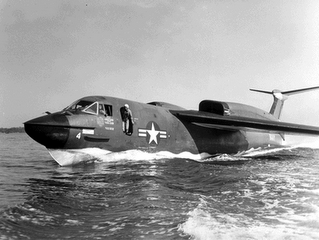



First it was a normal World War II fleet submarine with a distinguished record as set out here, with six war patrols, several kills and many rescues of downed pilots. After the war, USS Guavina was placed in reserve for a few years.
Then, in 1949, things changed:
From March 1949, Guavina underwent extensive overhaul and modification for conversion to a submarine oiler at Mare Island, and was even equipped with a snorkel. Guavina recommissioned in the active fleet as SSO-362 1 February 1950 at Mare Island. After operations along the West Coast, she sailed to Norfolk via Balboa and San Juan 24 July to 25 August. Further operations out of Norfolk were followed by overhaul at Philadelphia and on 29 January 1951, Guavina reported to Key West, her new homeport.Well, okay, but there's more to the story. And that "more" is an airplane - seaplane, actually, the jet powered Martin P6M Seamaster:
Operating out of Key West, Guavina cruised to the Caribbean and up the East Coast to Nova Scotia to test the concepts of fueling seaplanes and other submarines, although most of her work was in the Gulf of Mexico and the Straits of Florida. After overhaul at Philadelphia 18 April to 26 July 1952, Guavina was redesignated AGSS-362. Two more years of operations along the East Coast and in the Gulf were followed by a second extensive overhaul at Philadelphia. To aid refueling, Guavina gained a large, raised platform over the after torpedo room, which was soon dubbed the "flight deck."
And a flight deck it soon became as in January 1956 Guavina began testing the concept of mobile support of seaplanes from a submarine oiler. After an initial 2-week trial period, Guavina and a variety of seaplanes carried out refueling development for most of 1956. Sailing from Charleston 18 September, the submarine headed for the Mediterranean. After her 2-month deployment there with the 6th Fleet and Patrol Squadron 56, Guavina returned to Key West 1 December, then put into Charleston for overhaul.
Emerging from overhaul 12 July 1957 with the new designation (AOSS-362), Guavina resumed her established pattern of testing various applications of submarine oiler and seaplane refueling concepts, operating principally in the Caribbean. Ranging along the coast from New London to Bermuda, she also engaged in antisubmarine exercises and other peacetime training missions. Guavina sailed into the Charleston Navy Yard 4 January 1959, and decommissioned there 27 March, going into reserve.
The Martin SeaMaster was designed in the early 1950s as a jet-powered seaplane bomber which could carry a nuclear weapon from virtually any body of water; lack of super-carriers at the time prevented the U.S. Navy from having a major strategic weapons strike force to compete with the Air Force and its long-range bombers. The first XP6M-1 SeaMaster flew on July 14, 1955 and the second prototype rolled out in November. This seaplane, which could operate with only a tender or submarine to provide fuel and armament, represented the zenith for U.S. seaplane development and is a good example of the aggressive innovation in aircraft design that took place in the 1950s. The SeaMaster prototype had a gross take-off weight of 160,000 lbs.More here:
***
In the post-World War II period, the US Air Force built up the "Strategic Air Command", a nuclear strike force of long-range bombers. The US Navy realized that the strategic nuclear mission was now of overwhelming importance, all the more so because defense budgets were being cut, and wanted to build up their own nuclear strike capability to prevent them from being overshadowed by the Air Force / SAC.
Proposals to build a "super carrier", the USS UNITED STATES, as a floating base for Navy strategic bombers were shot down in 1949, and so the Naval Bureau of Aeronautics came up with another scheme, the "Seaplane Striking Force (SSF)". The SSF envisioned a fleet of big, jet-powered seaplanes that would not only be capable of long-range nuclear strike, but would also be useful for conventional bombing, reconnaissance, and mining. Laying mines was seen as particularly important, since to reach the open seas the Soviet Navy had to pass through a number of "bottlenecks" that could be blocked by mining. The seaplanes would be able to operate from advanced areas, supported by a seaplane tender or even a submarine.
***
Despite the loss of both prototypes, the Navy still remained enthusiastic about the SeaMaster. A beaching cradle was designed to allow SeaMasters to taxi in and out of the water, and two LSDs (landing ship docks), two seaplane tenders, and the submarine USS GUAVINA were sent to shipyards to fit them as SeaMaster support vessels. A home base was set up at Naval Air Station Harvey Point, near Elizabeth City, North Carolina.
A beaching cradle was designed that allowed SeaMasters to taxi in and out of the water on their own power. Two old amphibious-warfare dock ships and two conventional seaplane tenders began shipyard conversions as support ships for the SSF. The submarine U.S.S. Guavina, redesignated as an AO(SS) "oiler," was equipped to refuel SeaMasters at secret seadromes. There were also plans to use an old escort carrier equipped with a retractable rear ramp for "beaching" P6M's, which were too heavy to be hoisted aboard by cranes.Eventually the seaplane program was dropped and Guavina returned to more normal submarine operations.
But for a brief period of time, she was very special.
No comments:
Post a Comment